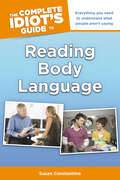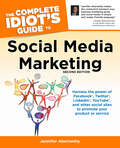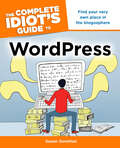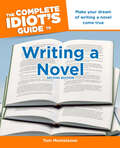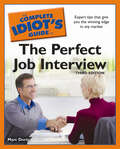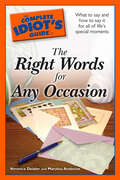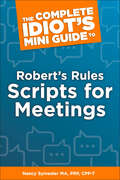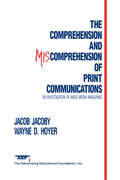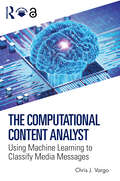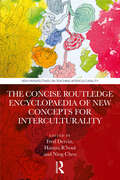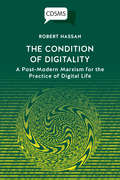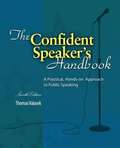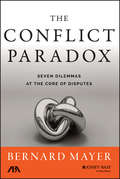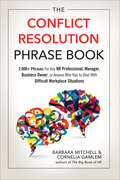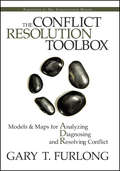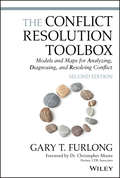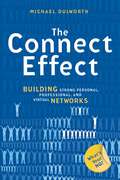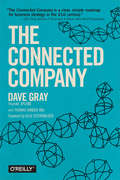- Table View
- List View
The Complete Idiot's Guide to Reading Body Language: Everything You Need to Understand What People Aren’t Saying
by Susan ConstantineUsing both photos and line art, The Complete Idiot's Guide® to Reading Body Language reveals and explains the visual tells to be found in faces, eyes, and lips; the positions of hands, arms, and legs; stances; gestures; the uses of everyday objects; and more. Additionally, strategies to elicit body language are detailed as well.
The Complete Idiot's Guide to Social Media Marketing, 2nd Edition
by Jennifer AbernethyThe Complete Idiot's Guide® to Social Media Marketing, Second Edition, covers cutting-edge techniques for small and large businesses alike. Ask the AuthorQ: How has social media marketing changed business and personal lives?A: The playing field has been leveled for business. No longer do you need a 6 or 7 figure budget to reach people around the country or globe for that matter. Personally, many lives have been affected. Many people more connected, businesses have grown because of the connections, TV and singing careers have been launched, money has been raised for charity, books have been marketed and purchased, and so on.Q: What has been the most challenging part of utilizing social media?A: I think the learning curve. With all of these sites . . . they come with no directions and no LIVE phone number.Q: What has worked the best and worst thus far?A: Facebook because of it&’s broad reach really has worked for me, but many would argue that YouTube works the best; particularly since it is the search engine of choice with the 11–34 age group.Q: How can a person searching for a job use social media marketing?A: So many ways. . . . They need to be on LinkedIn with a professional looking profile, photo, and contact information. They could also utilize video to begin sharing their expertise. Candidates need to stand out in a crowd of millions so if they say . . . sent in a video introducing themselves and a video follow up email . . . that would wow them!Q: What is the newest thing since Twitter?A: I believe companies and individuals are starting to utilize audio for creating their own iTunes channel, and also location-based social media like FourSquare. I personally, am not sold on location based services as of yet from a safety point of view, but for retailers it can be a good thing. I believe video is going to explode in popularity in 2011 for the 35+ market as well. They just need to get comfortable being on camera!
The Complete Idiot's Guide to Success as a Professional Speaker
by Thomas A. LiskGet the gift of gab. In this guide, readers will find indispensable information on how to pursue public speaking as a full- or part-time career. Written by a 30-year veteran public speaker and bureau chief, this book shares details, advice, and insider tips on how to prosper in this highly competitive and lucrative field. Expert author in a rapidly growing field Contains inside tips on every aspect of speaking professionally Clear and practical information about how to set up a professional speaker's business and promote it Suggestions for extra goods and services for additional revenue Features event planning and organizing strategies and instructive anecdotes from the field
The Complete Idiot's Guide to WordPress: Find Your Very Own Place in the Blogosphere
by Susan GuneliusTake advantage of the #1 blog publishing application. With more than 22 million users worldwide, WordPress is the #1 blog WordPress publishing application in the world. This guide provides users of both its hosted blogging service (WorldPress.com) and its self-hosted application (WordPress.org) with everything they need to know to create, customize, manage, and share their WordPress blogs with the world.
The Complete Idiot's Guide to Writing For Young Adults
by Deborah PerlbergThis comprehensive guide introduces aspiring storytellers to the ins and outs of writing fiction and nonfiction for young adults. Information includes an overview of writing, from dialogue and point of view to plot, setting, and character construction; choosing an agent and publisher; marketing the finished work; and more. - Written by an experienced author who has written, edited, and published books for young adults. - Features writing exercises, anecdotes, and insider information. - YA is a popular and lucrative genre for aspiring and seasoned authors alike, both in fiction and nonfiction.
The Complete Idiot's Guide to Writing Nonfiction: Essential Information on Researching, Organizing, and Writing Narrative Nonficti
by Christina BoufisNarrative nonfiction, also known as creative nonfiction or literary nonfiction, is true stories told using literary techniques and creativity. Narrative nonfiction essays are often featured in magazines such as Esquire, The New Yorker, Vanity Fair, and Harper's. Book-length narrative nonfiction works have grown in popularity since Truman Capote published In Cold Blood in 1965. Nonfiction works such as Into Thin Air, The Orchid Thief, The Perfect Storm, and Seabiscuit have smashed sales records and brought the genre into focus for the mainstream. With the rise of self-publishing and blogs comes a new generation of writers who want to tell their stories to a wider audience. The Complete Idiot's Guide® to Writing Nonfiction gives narrative nonfiction writers the instruction and tools they need to elevate their storytelling to an art form that appeals to more readers. In this book readers learn: What narrative nonfiction is. The literary building blocks of narrative nonfiction. How to research nonfiction subjects. Tricks for remembering details of events from one's own life story. How to conduct interviews for a book or article. How to find inspiration when writing nonfiction stories. Word choice and grammar help. How to overcome roadblocks such as stalled motivation and inhibitions when writing about real, living people. How to craft several types of narrative nonfiction by example. How to find markets for their work and get published. In addition, author Christina Boufis interviews successful narrative nonfiction writers in many subgenres and gets their insights on what inspires them and how they overcome their own obstacles.
The Complete Idiot's Guide to Writing a Novel, 2nd Edition: Make Your Dream of Writing a Novel Come True
by Tom MonteleoneA completely updated guide for first-time novelists Completely revised to include new interviews with best-selling authors; more detailed information on writing genre fiction from paranormal romance to cozy mysteries; and everything a writer needs to know about self-publishing and ebooks to get started. The Complete Idiot's Guide® to Writing a Novel, Second Edition, is an indispensable reference on how to write and publish a first novel. • Expert author with over thirty published novels • Includes interviews with new best-selling novelists • Features new material on writing genre fiction and self-publishing
The Complete Idiot's Guide to the Perfect Job Interview, 3rd Edition
by Marc DorioHow to ace an interview in today&’s competitive job market. Career human resources expert Marc Dorio knows how the system works and how it has changed with the advent of Internet interviews, video conferences, and electronic resumés. In this new edition, he teaches job seekers how to respond to obscure, difficult questions; research salary ranges and negotiate; pull together a resumé package; present their skill set and experience to best effect; follow up after the usual &“thank you&” note; and dozens of other inside tips. • From a human resources expert. • Strong sales record for past editions. • Most current information available. • Specific details about each step in the process.
The Complete Idiot's Guide to the Perfect Resume, 5th Edition: Give Your Resume a Professional Makeover—and Stand Out from the Pack
by Susan IrelandResumé: revamped for the times, technology, and the recession . . . The recession has made finding a job harder than ever. Everything now takes place online, and a resumé's preparation is different than even a few years ago. This new edition has changed with the times, focusing on what's most important in an electronic resumé. Full of successful resumé samples and cover letters, the book also focuses on the key words and phrases that will bring readers' resumés to the top of the HR pile. • More than 100 samples of real-life resumés and cover letters, many of them new • Founded in real-life experience without the rigid resume-writing rules of other guides • Ideal for all job seekers, from new grads to the laid off worker, new mothers to senior citizens
The Complete Idiot's Guide to the Right Words for Any Occasion
by Marylou Ambrose Veronica DeislerYour thoughts are worth more than a penny. You&’re no idiot, of course. You know words possess tremendous power. But expressing your feelings during special events or difficult situation requires more than a clichéd greeting-card sentiments. The Complete Idiot&’s Guide® to the Right Words for Any Occasion shows you exactly how to spell it out—in your own words. In this Complete Idiot&’s Guide®, you get: • Over 250 sample notes for the moments that touch people&’s lives, from wedding and anniversaries to birthdays and graduations. • Inspiration quotes to help you add just the right sentiment when you can&’t find your own words. • Guidance on what to say—and what not to say—during hard times. • Great ways to share your special message with people of all ages and faiths.
The Complete Idiot's Mini Guide to Creating Your Own Wordpress.Com Blog
by Clinton BonnerLearn how to create your own Wordpress.com blog with this helpful guide! The Complete Idiot&’s Mini Guide to Creating Your Own Wordpress.com Blog gives user-friendly, step-by-step directions for building a successful blog. Topics covered include how to coding a blog theme, publishing posts, as well as installing additional beneficial applications.
The Complete Idiot's Mini Guide to Robert's Rules Scripts for Meetings
by Nancy SylvesterThe whens, hows and whys of keeping order.Robert's Rules have long been the ultimate guide for running meetings and outlining procedures. The Complete Idiot's Guide(r) to Robert's Rules Scripts for Meetings, teaches readers everything from the ladder of motions to how to use Robert's Rules for any size or type of meeting or political caucus.This book includes sample minutes, a sample agenda, and scripts for every type of meeting situations.
The Comprehension and Miscomprehension of Print Communication
by Jacob Jacoby Wayne D. HoyerFirst Published in 1987. To writers and visualizers, this study sets a range of expectations for comprehension and miscomprehension—pointing the finger of caution that even what seems the simplest of language can be misunderstood, but also calling forth their best efforts, because this benchmark study shows that some communications can be much more successful than others and there is usually room for improvement. To advertisers, the study says that perhaps we often take comprehension too much for granted, being satisfied when consumers respond with something in the general area of our message, rather than in the precise area of what is meant. To academicians, the study gives reliable reference points for thought and dialogue among themselves and the advertising and publishing communities. It underlines what intuitive editors and writers have always known but have not always practiced: that words and ideas are fragile—handle with care if you hope to deliver them intact from one mind to another.
The Computational Content Analyst: Using Machine Learning to Classify Media Messages
by Chris J. VargoMost digital content, whether it be thousands of news articles or millions of social media posts, is too large for the naked eye alone. Often, the advent of immense datasets requires a more productive approach to labeling media beyond a team of researchers. This book offers practical guidance and Python code to traverse the vast expanses of data—significantly enhancing productivity without compromising scholarly integrity. We’ll survey a wide array of computer-based classification approaches, focusing on easy-to-understand methodological explanations and best practices to ensure that your data is being labeled accurately and precisely. By reading this book, you should leave with an understanding of how to select the best computational content analysis methodology to your needs for the data and problem you have.This guide gives researchers the tools they need to amplify their analytical reach through the integration of content analysis with computational classification approaches, including machine learning and the latest advancements in generative artificial intelligence (AI) and large language models (LLMs). It is particularly useful for academic researchers looking to classify media data and advanced scholars in mass communications research, media studies, digital communication, political communication, and journalism.Complementing the book are online resources: datasets for practice, Python code scripts, extended exercise solutions, and practice quizzes for students, as well as test banks and essay prompts for instructors. Please visit www.routledge.com/9781032846354.
The Concise Routledge Encyclopaedia of New Concepts for Interculturality (New Perspectives on Teaching Interculturality)
by Fred Dervin Ning Chen Hamza R’boulThis groundbreaking encyclopaedia presents 74 innovative concepts selected and elaborated by multilingual scholars, enriching critical discussions of the notion of interculturality in global scholarship.Many scholars are currently attempting to un-re-think and decolonize interculturality in different fields of research. Although ideas are critiqued and revised, this is happening in very similar linguistic terms as before. These potential attempts to decentre and decolonize could then be put into question. This book argues that knowledge production and negotiation should be exercised through alternative linguistic strategies, not for the sake of sounding different, but to advance new ways of defining, knowing and problematizing. The need to develop concepts in English and other languages is thus promoted in this encyclopaedia.Students, scholars and teachers with a sound background in intercultural studies will benefit most from the book. It will also appeal to anyone wishing to explore new ways of thinking, researching, speaking and writing about interculturality.
The Condition of Digitality: A Post-Modern Marxism for the Practice of Digital Life (Critical Digital and Social Media Studies #2517-1623)
by Robert HassanDavid Harvey’s The Condition of Postmodernity rationalised capitalism’s transformation during an extraordinary year: 1989. It gave theoretical expression to a material and cultural reality that was just then getting properly started – globalisation and postmodernity – whilst highlighting the geo-spatial limits to accumulation imposed by our planet. However this landmark publication, author Robert Hassan argues, did not address the arrival of digital technology, the quantum leap represented by the move from an analogue world to a digital economy and the rapid creation of a global networked society. Considering first the contexts of 1989 and Harvey’s work, then the idea of humans as analogue beings he argues this arising new human condition of digitality leads to alienation not only from technology but also the environment. This condition he suggests, is not an ideology of time and space but a reality stressing that Harvey’s time-space compression takes on new features including those of ‘outward’ and ‘inward’ globalisation and the commodification of all spheres of existence. Lastly the author considers culture’s role drawing on Rahel Jaeggi’s theories to make the case for a post-modern Marxism attuned to the most significant issue of our age. Stimulating and theoretically wide-ranging The Condition of Digitality recognises post-modernity’s radical new form as a reality and the urgent need to assert more democratic control over digitality.
The Confident Speaker's Handbook: A Practical Hands-on Approach to Public Speaking Fourth Edition
by Thomas ValasekThis book is designed to help you become a better public speaker by presenting a practical, hands-on approach to public speaking.
The Conflict Paradox: Seven Dilemmas at the Core of Disputes
by Bernard S. MayerFind the roadmap to the heart of the conflict The Conflict Paradox is a guide to taking conflict to a more productive place. Written by one of the founders of the professional conflict management field and co-published with the American Bar Association, this book outlines seven major dilemmas that conflict practitioners face every day. Readers will find expert guidance toward getting to the heart of the conflict and will be challenged to adopt a new way to think about the choices disputants face,. They will also be offered practical tools and techniques for more successful intervention. Using stories, experiences, and reflective exercises to bring these concepts to life, the author provides actionable advice for overcoming roadblocks to effective conflict work. Disputants and interveners alike are often stymied by what appear to be unacceptable alternatives,. The Conflict Paradox offers a new way of understanding and working with these so that they become not obstacles but opportunities for helping people move through conflict successfully.. Examine the contradictions at the center of almost all conflicts Learn how to bring competition and cooperation, avoidance and engagement, optimism and realism together to make for more power conflict intervention Deal effectively with the tensions between emotions, and logic, principles and compromise, neutrality and advocacy, community and autonomy Discover the tools and techniques that make conflicts less of a hurdle to overcome and more of an opportunity to pursue Conflict is everywhere, and conflict intervention skills are valuable far beyond the professional and legal realms. With insight and creativity, solutions are almost always possible. For conflict interveners and disputants looking for an effective and creative approach to understanding and working with conflict , The Conflict Paradox provides a powerful and important roadmap for conflict intervention.
The Conflict Resolution Grail: Awareness, Compassion and a Negotiator's Toolbox
by Meysa MalekiGlobal conflict is one of the top challenges the world faces today. Our survival as the human race demands that we pay attention to our own role in conflict. Resolving conflict on a global scale requires change at the level of individuals. Lawyer and Mediator Meysa Maleki introduces the everyday person to the elements of conflict, the sub-conversations and the skills that are required to resolve conflict effectively. However, her solution to addressing human conflict goes beyond just the latest conflict resolution theory, negotiation techniques, and the interpersonal skills of a mediator. She draws on the strengths of human beings, their capacity for compassion and their immense potential to change their subconscious programming through awareness. This book weaves together research ranging from human genetics, evolution, communications theory, neuroscience, world history, psychology, and sociology to reframe our understanding of conflict. It provides the everyday person as well as professionals who devote their careers to working with conflict situations with an integrated approach to conflict resolution. Meysa Maleki provides a new paradigm, one that is based on awareness, compassion, and a negotiator&’s toolbox.
The Conflict Resolution Phrase Book: 2,000+ Phrases For Any HR Professional, Manager, Business Owner, or Anyone Who Has to Deal With Difficult Workplace Situations
by Barbara Mitchell Cornelia GamlemA reference to help business leaders and human resources managers dissolve office disputes and foster dialogue with employees.Ouch! Did I really say that? What was I thinking? It’s uncomfortable to go into a tenuous situation blind and fumbling for words. That’s why people run from conflict.Rather than avoid these situations, The Conflict Resolution Phrase Book can help you prepare for and embrace them. Sometimes you just need a prompt to say the right thing, and that’s what this book will do. Using it you’ll learn:Positive things to say when initiating or responding to difficult conversations and situationsHow to find and craft language to start a sensitive conversationThe right words to positively influence the situationThe more you practice, the better you’ll become. Having this book at your fingertips will give you the confidence that the words will come out right. The Conflict Resolution Phrase Book is a natural complement to the author’s previous book, The Essential Workplace Conflict Handbook.“Barbara and Cornelia take the fear out of managing conflict and difficult conversations.” —Adam Bowman, MA. PHR“A ready resource on how to talk differently to get different results when managing conflict. It is a must have for the manager or HR professional.” —Marsha Hughes-Rease, MSOD, PCC, CAPT/NC/USN/Ret., Quo Vadis Coaching and Consulting, LLC
The Conflict Resolution Toolbox: Models and Maps for Analyzing, Diagnosing, and Resolving Conflict
by Gary T. FurlongIn real-life conflict resolution situations, one size does not fit all. Just as a mechanic does not fix every car with the same tool, the conflict resolution practitioner cannot hope to resolve every dispute using the same technique. Practitioners need to be comfortable with a wide variety of tools to diagnose different problems, in vastly different circumstances, with different people, and resolve these conflicts effectively. The Conflict Resolution Toolbox gives you all the tools you need: eight different models for dealing with the many conflict situations you encounter in your practice. This book bridges the gap between theory and practice and goes beyond just one single model to present a complete toolbox - a range of models that can be used to analyze, diagnose, and resolve conflict in any situation. It shows mediators, negotiators, managers, and anyone needing to resolve conflict how to simply and effectively understand and assess the situations of conflict they face. And it goes a step further, offering specific, practical guidance on how to intervene to resolve the conflict successfully. Each model provides a different and potentially useful angle on the problem, and includes worksheets and a step-by-step process to guide the reader in applying the tools. Offers eight models to help you understand the root causes of any conflict. Explains each model's focus, what kind of situations it can be useful in and, most importantly, what interventions are likely to help. Provides you with clear direction on what specific actions to choose to resolve a particular type of conflict effectively. Features a detailed case study throughout the book, to which each model is applied. Additional examples and case studies unique to each chapter give the reader a further chance to see the models in action. Includes practical tools and worksheets that you can use in working with these models in your practice. The Conflict Resolution Toolbox equips any practitioner to resolve a wide range of conflicts. Mediators, negotiators, lawyers, managers and supervisors, insurance adjusters, social workers, human resource and labour relations specialists, and others will have all the tools they need for successful conflict resolution.
The Conflict Resolution Toolbox: Models and Maps for Analyzing, Diagnosing, and Resolving Conflict
by Gary T. FurlongPRAISE FOR THE CONFLICT RESOLUTION TOOLBOX SECOND EDITION "I have been using and recommending The Conflict Resolution Toolbox since its first edition. It is rare to find a resource with such practical tools in a field that is so concrete, but often struggles to bridge theory and practice. In this increasingly complex world, it is vital to have models to resort to when we reach impasse in conflict. I recommend The Conflict Resolution Toolbox to anyone engaged in resolving conflicts in any discipline." —Martha E. Simmons, JD, LLM, PHD, Academic Director, Winkler Institute of Dispute Resolution and Director, Mediation Clinic and Intensive Program, Toronto, Canada "We all know one thing about conflict: It is messy! Furlong's models offer mediators, facilitators, lawyers, psychotherapists and others 'a leg up' in more swiftly figuring out what is going on and what is needed. Furlong does not offer up a single 'truth', style or theory, so much as a collection of effective tools that professionals, groups and families can use to better understand what they are experiencing and how they can approach achieving better results. Highly recommended!" —James C. Melamed, JD, CEO, Mediate.com "Gary Furlong has done it again! A long-time leader in the conflict resolution field, Gary has added two new 'power tools' to what was already the essential conflict resolution toolkit. His new chapters in this Second Edition deal with 'The Law of Reciprocity' and 'Loss Aversion Bias'. I am proud and thankful to add this book to my already growing conflict resolution bookcase, knowing that this is a volume I will go to again and again. I highly recommend it for anyone in the field." —Rick Weiler, Mediator, Arbitrator, Weiler ADR Inc., Ottawa, Canada "Gary Furlong uniquely provides invaluable, practical tools that help in understanding, preventing, and resolving conflict. This is a must-have reference book for anyone who cares about mitigating the role destructive conflict plays in our professional and personal lives and finding strategic benefit in tools that work. Gary has created a book that is both aspirational and practical. It's so challenging to create simple-to-use tools supported by complex concepts and Gary does this better than anyone." —Joshua A. Gordon, JD, MA, Arbitrator for the Court of Arbitration of Sport, Senior Practitioner at the Sports Conflict Institute, and Woodard Family Foundation Fellow Senior Instructor of Sports Business at the University of Oregon Lundquist College of Business
The Connect Effect: Building Strong Personal, Professional, and Virtual Networks
by Michael DulworthNetworking is not mere socializing—it is a vital personal and professional development skill. An effective network can make you more knowledgeable, help you address critical issues, accelerate your career, and even improve your health and well-being. As a recent article in MIT’s Sloan Management Review reports, “What really distinguishes high performers from the rest of the pack is their ability to maintain and leverage their networks.” Networking is simply too important to be left to chance. In this book, Michael Dulworth shows how to take a conscious, systematic approach to networking. After a short quiz to measure your “networking quotient” (NQ), The Connect Effect identifies three distinct kinds of networks: personal, professional, and virtual. Dulworth examines their specific characteristics and offers strategies, tools, and resources for building up and making the best use of each one. Stories from Dulworth’s twenty years of experience running networks, as well as interviews with top executives, researchers, and thought leaders, provide insights and advice about how networks function in the real world. Few of us are born networkers, but anyone—introvert, extrovert, or in-between—can learn to master this important skill. And as you build your networks and the connections between members multiply, you’ll find that the benefits you gain grow exponentially. This extraordinary return on your networking investment is what Dulworth terms “The Connect Effect”—and in this book he shows how it can enrich every aspect of your life.
The Connected Company
by Dave Gray Thomas Vander Wal<p>To keep pace with today’s connected customers, your company must become a connected company. That means deeply engaging with workers, partners, and customers, changing how work is done, how you measure success, and how performance is rewarded. It requires a new way of thinking about your company: less like a machine to be controlled, and more like a complex, dynamic system that can learn and adapt over time. <i>The Connected Company</i> shows you how.</p>
The Connected Company
by Dave Gray Thomas Vander WalWith a foreword by Alex Osterwalder.The future of work is already here.Customers are adopting disruptive technologies faster than your company can adapt. When your customers are delighted, they can amplify your message in ways that were never before possible. But when your company’s performance runs short of what you’ve promised, customers can seize control of your brand message, spreading their disappointment and frustration faster than you can keep up.To keep pace with today’s connected customers, your company must become a connected company. That means deeply engaging with workers, partners, and customers, changing how work is done, how you measure success, and how performance is rewarded. It requires a new way of thinking about your company: less like a machine to be controlled, and more like a complex, dynamic system that can learn and adapt over time.Connected companies have the advantage, because they learn and move faster than their competitors. While others work in isolation, they link into rich networks of possibility and expand their influence.Connected companies around the world are aggressively acquiring customers and disrupting the competition. In The Connected Company, we examine what they’re doing, how they’re doing it, and why it works. And we show you how your company can use the same principles to adapt—and thrive—in today’s ever-changing global marketplace.
